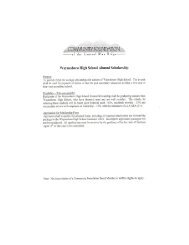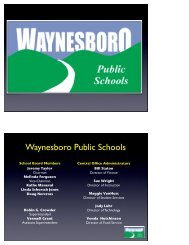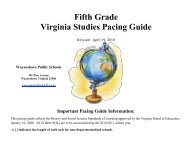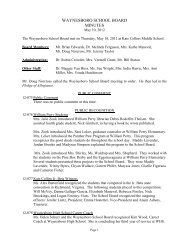Second Grade Reading Pacing Guide - Waynesboro Public Schools
Second Grade Reading Pacing Guide - Waynesboro Public Schools
Second Grade Reading Pacing Guide - Waynesboro Public Schools
You also want an ePaper? Increase the reach of your titles
YUMPU automatically turns print PDFs into web optimized ePapers that Google loves.
know, discussing real-life experiences,<br />
and providing vicarious experiences<br />
through reading.<br />
• Students will demonstrate comprehension<br />
of story elements in fiction by identifying<br />
the characters, setting, and main idea.<br />
• The main idea is the most important idea<br />
from the paragraph or story.<br />
• Teachers should provide opportunities for<br />
students to respond in writing to what is<br />
read.<br />
2.9 The student will read and demonstrate comprehension of nonfiction texts.<br />
a) Preview the selection using text features.<br />
b) Make and confirm predictions about the main idea.<br />
d) Set purpose for reading.<br />
UNDERSTANDING THE STANDARD<br />
(Background Information for<br />
Instructor Use Only)<br />
• Students will also begin to learn the skills<br />
of summarizing and skimming to locate<br />
specific information in nonfiction text.<br />
• The main idea is the most important idea<br />
from the paragraph or story.<br />
ESSENTIAL UNDERSTANDINGS<br />
All students should:<br />
• demonstrate comprehension of<br />
nonfiction.<br />
• understand that comprehension<br />
requires making, confirming and<br />
revising predictions.<br />
• understand that they must attend to<br />
the details of the text in order to<br />
comprehend.<br />
2.10 The student will demonstrate comprehension of information in reference materials.<br />
c) Use dictionaries, glossaries, and indices.<br />
UNDERSTANDING THE STANDARD ESSENTIAL UNDERSTANDINGS<br />
(Background Information for<br />
All students should:<br />
• find evidence to support<br />
predictions (e.g., return to text to<br />
locate information, support<br />
predictions, and answer questions).<br />
• begin to skim for information to<br />
answer questions<br />
• explain how illustrations and<br />
images contribute to and clarify<br />
text.<br />
ESSENTIAL KNOWLEDGE AND<br />
SKILLS<br />
To be successful with this standard,<br />
students are expected to:<br />
• use titles, headings, and<br />
subheadings to generate ideas<br />
about the text (Use Science Link)<br />
• use print clues, such as italics to<br />
assist in reading<br />
• skim text for section headings to<br />
help set a purpose for reading.<br />
ESSENTIAL KNOWLEDGE AND<br />
SKILLS<br />
44









